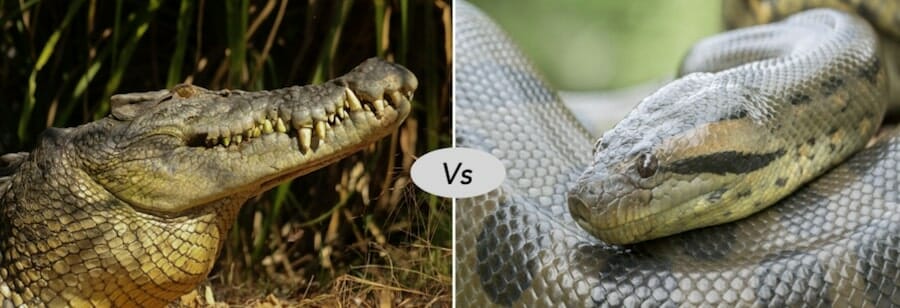While some animals have similar attacking and ambushing techniques, in most cases, size matters, some animals are so ferocious and territorial that they will prey on anything that comes in their way. In contrast, others are more strategic in their attack. What happens when the strongest croc meets the most massive snake? What will win – Green Anaconda vs salt water Crocodile?
What are important facts on Green Anaconda?
The Green Anaconda or the common Anaconda is most commonly found in and is native to South America. It is the most massive known snake species, and while the reticulated python might have a few inches on the common Anaconda, its girth makes it more substantial than any snake species.
What does a Green Anaconda eat?
Being carnivorous, the Green Anaconda feeds on nearly anything it can catch. Its prey can be anything between small creatures such as birds, fish, and mice to larger mammals like deers and capybaras.
How big are Green Anacondas?
Although determining the maximum length and weight of the Green Anaconda has been difficult, the average adult can weigh up to 30-70 Kgs. Females can measure up to a length of over 15 feet, and males can measure up to 17ft in length.
The Green Anaconda just so happens to be the heaviest and one of the longest snakes in the world.
How does the Green Anaconda reproduce?
Mostly solitary beings, Green Anacondas mate during the monsoon season. The gestation period lasts for about 6 to 7 months. The number of offsprings in a litter usually range form 20-40 but can also measure up to a 100.
How does Green Anaconda hunt?
The Green Anaconda is a non-venomous snake but overpowers its prey and enemy by constriction. The Green Anaconda is known to ambush its prey and not chase it. By wrapping its body around the victim, the Anaconda constricts blood flow till the prey suffocates and dies. The Anaconda mostly preys in and around water bodies and can move at high speeds in water.
Where do you found Saltwater Crocodile?
The saltwater crocodile or Crocodylus porosus can be found in, as the name suggests, saltwater habitats and wetlands. It can be located on the Indian east coast, parts of Southeast Asia, northern Australia, and Micronesia. The saltwater crocodile is also allegedly the most extensive living crocodilian. Owing to its sheer size, the saltwater crocodile can live off minimal food for extended periods.
What does a Saltwater Crocodile eat?
The saltwater crocodile will feast on pretty much everything that crosses its path. A meal can range from smaller animals like fish, crustaceans, birds, bats to more massive creatures such as deers, wild boars, buffalos, small sharks, tigers, and even humans!
What is length and size of a salt water crocodile?
A male saltwater crocodile can measure up to 20 feet and can weigh as much as 1,000 Kgs. Females are relatively smaller and almost have the length of the adult male.
How does the Saltwater Crocodile reproduce?
A female saltwater crocodile can lay up to 60 eggs and 90 in rare cases. Only 1% of the offsprings have a chance at adulthood, and the families disperse after reaching eight months.
What is lifespan of a salt water crocodile?
The average lifespan of a saltwater crocodile is 70 years.
How does a salt water crocodile hunt?
A saltwater crocodile is a hyper carnivorous apex predator, and, yes, it is as scary as it sounds. These creatures will prey on anything that enters their territory and are known to be human hunters. The crocodile not only can capture and drown its prey but can also leap several feet into the air to knock off smaller creatures from tree branches.

Green Anaconda vs Saltwater Crocodile fight comparison, who will win?
While the Anaconda may have girth and swiftness and rapid movement on its side, there isn’t much that it will be able to do owing to the enormous size of the crocodile. The ambushing and constricting technique will not work on the saltwater crocodile.
Both these reptiles use similar methods to ambush their prey; however, in a situation where a fight was to arise between the two the crocodile would win.
While their sharp, pegged teeth don’t do much for tearing flesh, they provide a death grip that allows the crocodile to drown their prey or crush them and allows them to feed on the prey later. I hope you like reading on Green Anaconda vs Saltwater crocodile.

